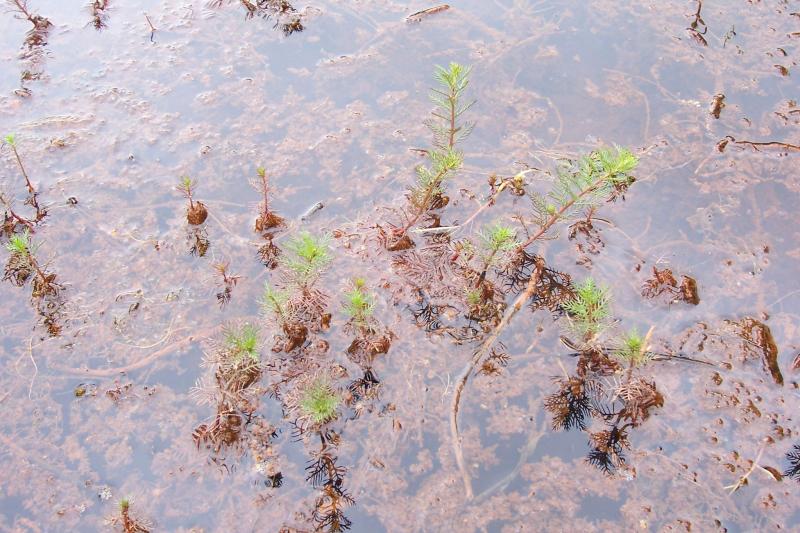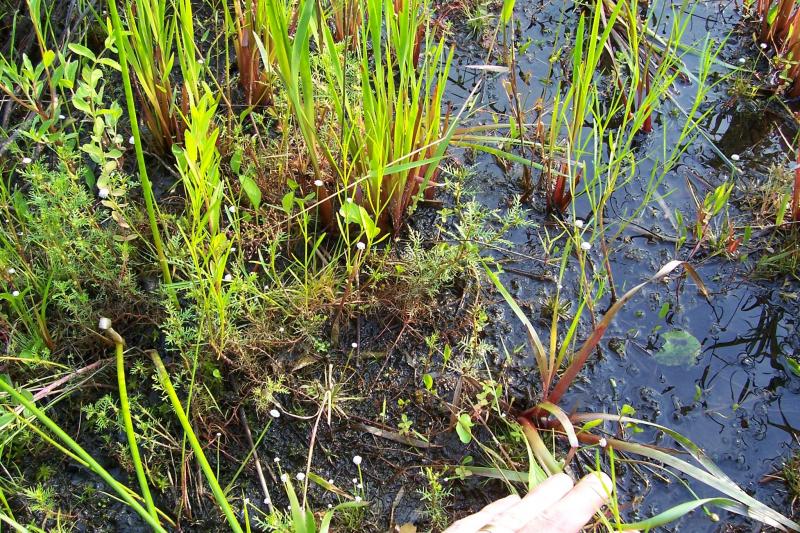Comb-leaved Mermaid Weed
Proserpinaca pectinata Lam.
- Class
- Dicotyledoneae (Dicots)
- Family
- Haloragaceae (Water-Milfoil Family)
- State Protection
- Threatened
Listed as Threatened by New York State: likely to become Endangered in the foreseeable future. For animals, taking, importation, transportation, or possession is prohibited, except under license or permit. For plants, removal or damage without the consent of the landowner is prohibited.
- Federal Protection
- Not Listed
- State Conservation Status Rank
- S2
Imperiled in New York - Very vulnerable to disappearing from New York due to rarity or other factors; typically 6 to 20 populations or locations in New York, very few individuals, very restricted range, few remaining acres (or miles of stream), and/or steep declines.
- Global Conservation Status Rank
- G5
Secure globally - Common in the world; widespread and abundant (but may be rare in some parts of its range).
Summary
Did you know?
The species name is Latin for comb-like and refers to the appearance of the dissected leaves (Fernald 1950).
State Ranking Justification
There are six existing populations and three of them consist of multiple ponds that are hydrologically connected. Most of the populations are on protected parkland, but they may still be subject to some disturbance. There are two historical populations from the 1920s that have not been resurveyed.
Short-term Trends
Most of the populations have been surveyed at least twice and their short-term trend seems to be stable. However, fluctuating water levels make understanding the exact trend difficult.
Long-term Trends
The long-term trend appears stable as there are as many or even more populations now than were known in the past. This is a result of more detailed surveys in the 1980s and the protection of many of the coastal plain ponds.
Conservation and Management
Threats
Some ponds have seen too much development along the shoreline which threaten populations with direct disturbance by trampling and ATV use. The invasion of Phragmites is also a threat to a few populations.
Conservation Strategies and Management Practices
The pondshores need to be protected from direct disturbance by ATVs and excessive trampling. Exotic invasive species must be prevented from colonizing the shores and present populations must be eliminated. A natural buffer of at least 200 feet should be established around the ponds to prevent excessive runoff and pollution events.
Habitat
Habitat
In New York this plant occurs almost exclusively on coastal plain pondshores. One occurrence occurs in a sedge meadow surrounded by wetland shrubs and another occurs in an artificial pond with a Sphagnum substrate surrounded by a maple swamp (New York Natural Heritage Program 2012). Sandy bogs of the coastal plain (Gleason and Cronquist 1991). Peaty or muddy quagmires, savannas and shallow water (Fernald 1950).
Associated Ecological Communities
- Coastal plain pond*
(guide)
The aquatic community of the permanently flooded portion of a coastal plain pond with seasonally, and annually fluctuating water levels. These are shallow, groundwater-fed ponds that occur in kettle-holes or shallow depressions in the outwash plains south of the terminal moraines of Long Island, and New England. A series of coastal plain ponds are often hydrologically connected, either by groundwater, or sometimes by surface flow in a small coastal plain stream.
- Coastal plain pond shore
(guide)
The gently sloping shore of a coastal plain pond with seasonally and annually fluctuating water levels. Plants growing on the pond shore vary with water levels. In dry years when water levels are low there is often a dense growth of annual sedges, grasses, and herbs. Submerged and floating-leaved aquatic plants, such as fragrant waterlily and pondweeds, may become "stranded" on the exposed shore. In wet years when the water level is high only a few emergents and floating-leaved aquatics may be noticeable. T
* probable association but not confirmed.
Associated Species
- Coreopsis rosea (pink coreopsis, pink tickseed)
- Eleocharis robbinsii (Robbins's spike-rush)
- Gratiola spp.
- Juncus militaris (bayonet rush)
- Nymphaea odorata
- Panicum sp.
- Rhexia virginica (Virginia meadow-beauty)
- Rhynchospora capitellata (brownish beak sedge)
- Rhynchospora macrostachya (tall horned beak sedge)
- Sagittaria spp.
- Utricularia spp.
Range
New York State Distribution
Long island and lower Hudson Valley.
Global Distribution
It is most common along the Atlantic and Gulf Coastal Plains from southern New Jersey south to northern Florida and west to eastern Texas. Farther north it is rare and scattered from Long Island to southern Maine except for Massachusetts where it is more common. It extends inland in the Southeast to central Tennessee.
Identification Comments
General Description
Comb-leaved mermaid-weed is a short aquatic plant with horizontal stems that root at the base and produce erect branches with leaves that stick out of the water. All of the leaves are deeply lobed into 6-12 narrow segment pairs that give the leaf a comb-like appearance (pinnatisect). The tiny single flowers (sometimes in twos or threes) arise in the axils of the upper leaves and have 3 green triangular sepals that enclose 3 stamens and 3 pinkish, frilly styles. There are no petals. The fruit is bony and ridged, sharply 3-angled with nearly flat sides. It has 3 seeds (Gleason and Cronquist 1991).
Best Life Stage for Proper Identification
The comb-like leaves are the key character for identification, so this plant may be identified whenever it can be found.
Similar Species
The more widespread Proserpinaca palustris, common mermaid-weed, has emersed leaves that are oblong and merely toothed instead of pinnatisect. The submerged leaves are pinnatisect (Gleason and Cronquist 1991).
Best Time to See
Comb-leaved Mermaid-weed emerges in late June and may persist into October.
- Vegetative
The time of year you would expect to find Comb-leaved Mermaid Weed vegetative in New York.
Comb-leaved Mermaid Weed Images
Taxonomy
Comb-leaved Mermaid Weed
Proserpinaca pectinata Lam.
- Kingdom Plantae
- Phylum Anthophyta
- Class Dicotyledoneae
(Dicots)
- Order Haloragales
- Family Haloragaceae (Water-Milfoil Family)
- Order Haloragales
- Class Dicotyledoneae
(Dicots)
- Phylum Anthophyta
Additional Common Names
- Mermaid-weed
Additional Resources
Best Identification Reference
Crow, Garrett E. and C. Barre Hellquist. 2000. Aquatic and Wetland Plants of Northeastern North America: A revised and enlarged edition of Norman C. Fassett's a Manual of Aquatic Plants. Volume One: Pteridophytes, Gymnosperms, and Angiosperms: Dicotyledons. The University of Wisconsin Press. Madison, Wisconsin. 536 Pages.
Other References
Fernald, M. L. 1950. Gray's manual of botany. 8th edition. Corrected printing (1970). D. Van Nostrand Company, New York. 1632 pp.
Gleason, Henry A. and A. Cronquist. 1991. Manual of Vascular Plants of Northeastern United States and Adjacent Canada. The New York Botanical Garden, Bronx, New York. 910 pp.
Holmgren, Noel. 1998. The Illustrated Companion to Gleason and Cronquist's Manual. Illustrations of the Vascular Plants of Northeastern United States and Adjacent Canada. The New York Botanical Garden, Bronx, New York.
New York Natural Heritage Program. 2010. Biotics database. New York Natural Heritage Program. New York State Department of Environmental Conservation. Albany, NY.
New York Natural Heritage Program. 2024. New York Natural Heritage Program Databases. Albany, NY.
Penskar, M.R. 2009. Special plant abstract for Proserpinaca pectinata (Comb-leaved Mermaid-weed). Michigan Natural Features Inventory, Lansing, MI. 3 pp.
Weldy, T. and D. Werier. 2010. New York flora atlas. [S.M. Landry, K.N. Campbell, and L.D. Mabe (original application development), Florida Center for Community Design and Research http://www.fccdr.usf.edu/. University of South Florida http://www.usf.edu/]. New York Flora Association http://newyork.plantatlas.usf.edu/, Albany, New York
Links
About This Guide
This guide was authored by: Stephen M. Young
Information for this guide was last updated on: September 6, 2012
Please cite this page as:
New York Natural Heritage Program. 2024.
Online Conservation Guide for
Proserpinaca pectinata.
Available from: https://guides.nynhp.org/comb-leaved-mermaid-weed/.
Accessed July 26, 2024.


